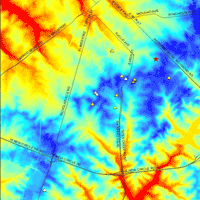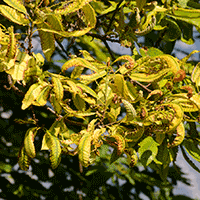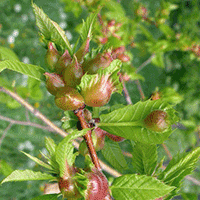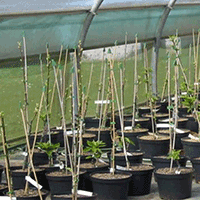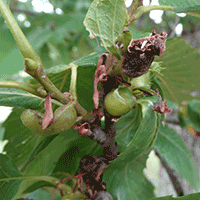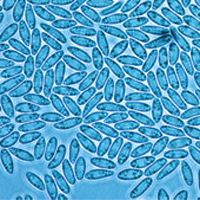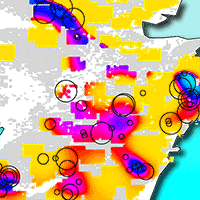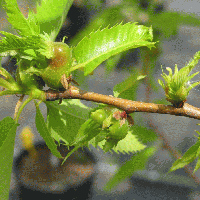
Case study of a new method for the classification and analysis of Dryocosmus kuriphilus Yasumatsu damage to young chestnut sprouts
A Maltoni , B Mariotti, A Tani
iForest - Biogeosciences and Forestry, Volume 5, Issue 2, Pages 50-59 (2012)
doi: https://doi.org/10.3832/ifor0598-008
Published: Apr 10, 2012 - Copyright © 2012 SISEF
Research Articles
Abstract
Dryocosmus kuriphilus is a new chestnut pest that is causing a serious problem worldwide. This gall wasp causes severe infestations of Italian Castanea sativa stands, which lowers their productivity. The most effective method for controlling gall wasp infestations is to introduce the parasitoid, Torymus sinensis, although experience shows that it can be 6-18 years before it is effective in reducing the infestation to acceptable levels. From a silvicultural point of view, it is important to reduce the damage as rapidly as possible to maintain plant vigour and fruit production, thereby avoiding chestnut stand degradation and abandonment before biological control is effective. This study analyzed the damage caused by Dryocosmus kuriphilus during normal plant development and detected differences in plant susceptibility, irrespective of genetic factors. Data were collected from a young Castanea sativa coppice stand in Tuscany (Italy) where damage was evaluated during the 2010 growing season. The study consisted of two phases: (1) classification of the damages caused by galls; and (2) studying the galls and damage distribution effects on different vigour chestnut sprouts to determine whether there were preferred oviposition sites or different degrees of susceptibility to gall wasp attack depending on a plant’s physiological state. The D. kuriphilus damage classification scale was based on two factors: damage position (the vegetative organ attacked) and damage effect (abnormal organ development caused by galls). This classification included damage types that had not been previously described in literature. The statistical analysis identified differences in damage susceptibility in terms of: axis (stem or branches), plant organs (shoots, leaves, or buds), position of the attacked node (high or low region of the axis), and sprout vigour. Information on the D. kuriphilus damage distribution and its effect on plants with different levels vigour can be used to develop suitable cultural practices that could reduce the negative impact of this insect on fruit and wood production.
Keywords
Castanea sativa, Chestnut gall wasp, Damage distribution, Damage susceptibility, Vegetative vigour
Authors’ Info
Authors’ address
B Mariotti
A Tani
Dipartimento di Economia, Ingegneria, Scienze e Tecnologie Agrarie e Forestali (DEISTAF), Università degli Studi di Firenze, v. San Bonaventura 13, I-50145 Firenze (Italy)
Corresponding author
Paper Info
Citation
Maltoni A, Mariotti B, Tani A (2012). Case study of a new method for the classification and analysis of Dryocosmus kuriphilus Yasumatsu damage to young chestnut sprouts. iForest 5: 50-59. - doi: 10.3832/ifor0598-008
Academic Editor
Alberto Santini
Paper history
Received: May 20, 2011
Accepted: Mar 07, 2012
First online: Apr 10, 2012
Publication Date: Apr 30, 2012
Publication Time: 1.13 months
Copyright Information
© SISEF - The Italian Society of Silviculture and Forest Ecology 2012
Open Access
This article is distributed under the terms of the Creative Commons Attribution-Non Commercial 4.0 International (https://creativecommons.org/licenses/by-nc/4.0/), which permits unrestricted use, distribution, and reproduction in any medium, provided you give appropriate credit to the original author(s) and the source, provide a link to the Creative Commons license, and indicate if changes were made.
Web Metrics
Breakdown by View Type
Article Usage
Total Article Views: 60662
(from publication date up to now)
Breakdown by View Type
HTML Page Views: 49608
Abstract Page Views: 3678
PDF Downloads: 5784
Citation/Reference Downloads: 30
XML Downloads: 1562
Web Metrics
Days since publication: 5012
Overall contacts: 60662
Avg. contacts per week: 84.72
Citation Metrics
Article Citations
Article citations are based on data periodically collected from the Clarivate Web of Science web site
(last update: Mar 2025)
Total number of cites (since 2012): 24
Average cites per year: 1.71
Publication Metrics
by Dimensions ©
Articles citing this article
List of the papers citing this article based on CrossRef Cited-by.
References
The diversity and phylogeography of cynipid gallwasps (Hymenoptera, Cynipidae) of the Eastern Palearctic and their associated communities. Oriental insect 41: 169-212.
Gscholar
Oriental chestnut gall wasp. Pest Alert NA-PR-02-93, USDA Forest Service, Northeastern Area, Ashville, NC, USA.
Gscholar
Dryocosmus kuriphilus Yasumatsu: an outline seven years after the first report in Piedmont (Italy). In: Proceedings of I European Congress on Chestnut “Castanea 2009”. Acta Horticulturae 866: 341-348.
Gscholar
Cinipide galligeno del castagno: primi risultati di lotta biologica e di valutazione della sensibilità varietale. In: “Atti del IV Convegno Nazionale Castagno 2005”. Montella (AV - Italy) 20-22 October 2005.
Gscholar
Dryocosmus kuriphilus found in South France (Alps maritimes). EPPO Reporting Service 5: 2008/086.
Gscholar
Situation of Dryocosmus kuriphilus in France. EPPO Reporting Service 5, 2008/097.
Gscholar
The breeding of resistant varieties to some insects and diseases in fruit trees. Japanese Journal of Breeding 11: 137-140.
Gscholar
Il cinipide del castagno. Diffusione e riflessioni su alcune pratiche colturali. Sherwood 165: 21-24.
Gscholar
Tradizione, innovazione e sostenibilità: una selvicoltura per il castagno da frutto. In: “Atti del Terzo Congresso Nazionale di Selvicoltura: per il miglioramento e la conservazione dei boschi italiani” (Ciancio ed). Accademia Italiana di Scienze Forestali pp. 851-857.
Online | Gscholar
Decline of the chestnut gall wasp population, Dryocosmus kuriphilus Yasumatsu (Hymenoptera: Cynipidae) after the establishment of Torymus sinensis Kamijo (Hymenoptera: Torymidae). Journal of Applied Entomology and Zoology 24 (2): 231-233.
Gscholar
Classical biological control of the chestnut gall wasp in Japan. In: Proceedings of the “First international symposium on biological control of arthropods” (van Driesche ed). Honolulu (Hawaii - USA) 14-18 January 2002. USDA Forest Service, Washington, USA, pp. 407-415.
Gscholar
Murakami Y (1981). Comparison of the adult emergence periods between Torymus (Syntomaspis) beneficus a native parasitoid of the chestnut gall wasp and a congeneric parasitoid imported from China (Hymenoptera: Torymidae). In: Proceedings of the Association for Plant Protection of Kyushu 27: 156-158.
CrossRef | Gscholar
Colonizationof imported Torymus (Syntomaspis) sinensis Kamijo (Hymenoptera: Torymidae) parasitic on the chestnut gall wasp (Hymenoptera: Cynipidae). Success in the eighteenth year after release in Kunamoto. In: Proceedings of the Association for Plant Protection of Kyushu 47: 132-134.
CrossRef | Gscholar
Dryocosmus kuriphilus Yasumatsu (Hymenoptera: Cynipidae), an oriental chestnut gall wasp in North America. Cooperative Economic Insect Report 25 (49-52): 903-905.
Gscholar
Il cinipide galligeno del castagno Terra trentina 53 (9): 24-29.
Gscholar
Evaluation of susceptibility to Dryocosmus kuriphilus Yasumatsu (Hymenoptera: Cynipidae) in Castanea sativa Miller and in hybrid cultivars. In: Proceedings of “International Workshop on Chestnut Management in Mediterranean Countries - Problems and Prospects” (Soylu, Mert eds). Bursa (Turkey). Acta Horticolturae 815: 289-294.
Gscholar
Studies on the breeding of chestnut, spp. II. Parasitic variation in the chestnut gall wasp, Dryocosmus kuriphilus Yasumatsu. Bullettin of the Horticultural Research Station, Ser. A 11, pp. 13. [In Japanese with English summary].
Gscholar
Riflessioni sull’effetto di pratiche colturali in castagneti con presenza di Dryocosmus kuriphilus. In: Proceedings of the “5° Congresso Nazionale Castagno - Castanea 2009”. Cuneo (Italy) 13-16 October 2009, pp. 75-82.
Gscholar


